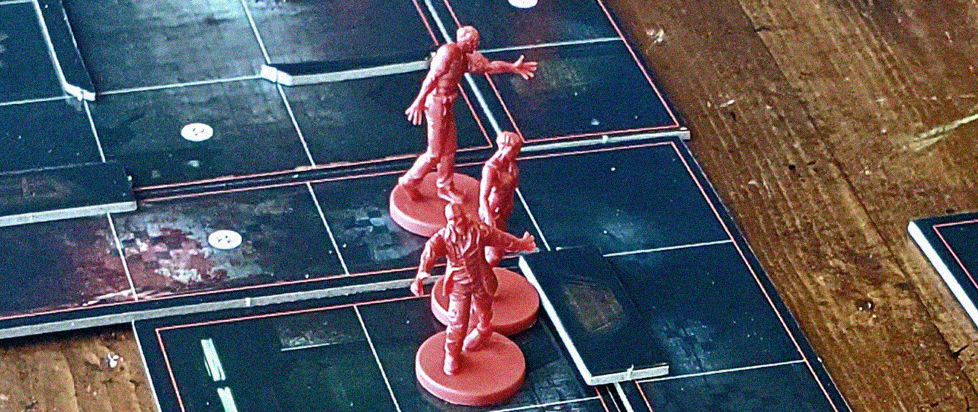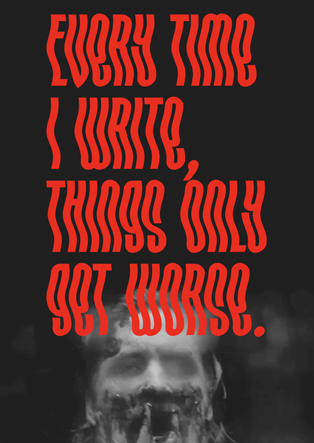
Rising Tension: The Odd and Appropriate Specificity of Resident Evil 2: The Board Game
I see board games in the store and they always look so cool and then I buy them and bring them home, I’m so excited to open them, and then I play them, like, twice… This column is dedicated to the love of games for those of us whose eyes may be bigger than our stomachs when it comes to playing, and the joy that we can all take from games, even if we don’t play them very often.
We live in strange times. As I write this, you can go to Target and pick up a board game based on Jaws or The Shining, and there are versions of Monopoly and Clue themed around everything from Godzilla to Aliens vs. Predator. So, why not a board game adaptation of Resident Evil 2, specifically?
On its face, a Resident Evil board game actually makes a lot of sense. The “survival horror” tone of the original video games seems like it would be both easy and fun to translate to the table, and the claustrophobic interiors of much of the series would lend themselves well to dungeon tiles. It’s the specificity that makes Resident Evil 2: The Board Game from Steamforged Games such an oddity. Why RE2, specifically?
I was actually curious enough to hear the history behind this that I sent Steamforged Games an email. “When we first started speaking to Capcom about the Resident Evil series and how it might look as a tabletop product, we very quickly arrived at the best game to adapt,” their response began, going on to explain that the decision to make the game Resident Evil 2, specifically, had to do with Capcom’s announcement of the RE2 remake, which was released around the same time as the board game.
That wasn’t the only reason they gave, though. “Capcom has always asked us to be very concise with our games,” they wrote, “and focus around a single release.” This helps them to focus on the “core identity of each release,” they said, “allowing us to really explore each narrative for them to the best of our abilities.”
You can see this in some of the other games they’ve released adapting oddly-specific video game properties like Bandai’s Ni no Kuni II, which I’ll be covering here at a later date.
Back in March, Resident Evil celebrated its 25th anniversary – reminding me that I am, indeed, an actual mummy – and so I decided it was high time for me to crack open my copy of Resident Evil 2: The Board Game and see how it stacked up against my memories of (mostly watching other people play, honestly, as I was never any good at the RE series) the real thing.
And the answer is, at least at first blush, pretty well. Bearing in mind that it has been a minute since I last played a Resident Evil game, and I never played any of them all that much, there are still a lot of obvious similarities at work here.
Around the same time as I was working on this column, friend and fellow writer William Tea was having a Facebook conversation in which he argued that the early “tank” controls of the Resident Evil games (since I’m writing this for Unwinnable, I’ll assume that I don’t have to explain any further than that) were “effective at inducing panic,” and I would say the board game’s mechanics often have that same ability.
As in the video game, every step you take feels like a potential sacrifice, and enemies can seemingly come out of the woodwork at a moment’s notice. You’ll spend long periods doing just fine and suddenly be overrun. You’ll have to go well out of your way just to find the rooster key, or whatever, and every tiny success will feel like a Herculean achievement. Your ammo will constantly feel like it’s running on empty and every time you take a shot and miss (which will happen often) it’ll be like a physical blow.
Perhaps the closest the board game comes to the panic-inducing controls of the original games is in how a turn operates. As in many games of this type, on each turn, your character gets a number of actions (4, in this case, which feels like a lot) that they can essay. Here’s the trick, though. In most games, characters have a certain (plural) number of spaces they can move each time they take the “move” action. Not in RE2. Every square you want to cross is a separate “move” action, and after every turn you take, nearby enemies get a turn to lurch forward and try to bite you, or whatever it is they do.
I played in solo mode, both because there’s a pandemic on and I don’t have any friends anyway (and Grace doesn’t like horror or zombies or any of this shit) and because I felt like solo mode would, in some ways, be an ideal way to experience the isolating horror of Resident Evil 2. Indeed, the rulebook even seems to agree with me, referring to solo mode as the way for players to “fully immerse themselves in the survival horror experience.”
In the couple of scenarios I essayed, I ran out of ammo both times, got chased by zombie dogs, fought a licker, and got immobilized in a hallway for two turns by grasping hands. Which sounds pretty well like the Resident Evil experience to me.
The tiles are nothing to write home about – the dark and claustrophobic interiors serve the tone of the game well, but render the artwork on the tiles little more than pools of darkness – but the models are nice enough, especially some of the big bads like the G Mutant, which I don’t remember from the game at all, but it looks dope.
I played as Robert Kendo (who I also don’t remember from the video game) who – thank fuck – has an ability that lets him re-roll some of his shooting rolls, or else I would have run out of bullets even faster. As it is, I ended up knifing as many zombies as I shot, easily, and running away from more than either.
It’s a game where there are actually reasons to spend an action running behind a door and then shutting it, and the sense that everything is closing in, that you have to shepherd all of your resources carefully and get through the scenario objective as quickly as you can manage lest you run out of everything and die in a pitch-dark hallway seems nicely redolent of the whole survival horror deal.





